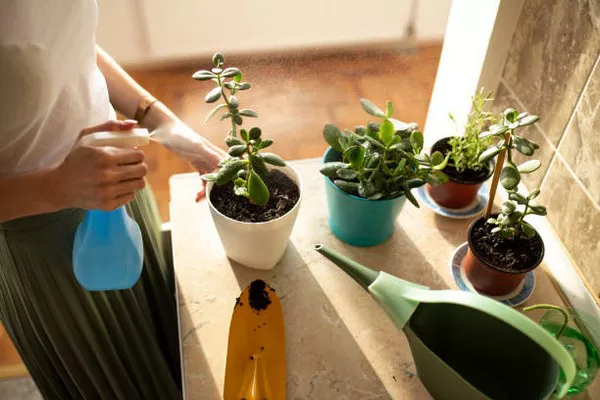Jade plants (Crassula ovata) are renowned for their striking appearance and resilience as houseplants. Native to South Africa, these succulents are favored for their low maintenance requirements and adaptability. One of the most effective methods for propagating jade plants is through cuttings. In this comprehensive guide, we will walk you through the step-by-step process of successfully growing jade plants from cuttings, ensuring that you can enjoy their unique beauty in your own home.
Understanding Jade Plant Cuttings
Before diving into the propagation process, it’s important to understand what jade plant cuttings are and why they are a preferred method of propagation.
What are Jade Plant Cuttings?
Jade plant cuttings are sections of the plant’s stems or leaves that are removed and rooted to create new plants. These cuttings can be taken from a mature jade plant, and when properly cared for, they can develop into healthy, fully-grown plants that closely resemble their parent plant.
Why Use Cuttings?
There are several advantages to using cuttings for jade plant propagation:
Genetic Continuity: Cuttings ensure that the new plant will have the same genetic characteristics as the parent plant, preserving its unique features and appearance.
Faster Growth: Propagating from cuttings typically results in faster growth compared to growing jade plants from seeds.
Simplicity: The process is straightforward, making it accessible to both novice and experienced gardeners.
Controlled Growth: You have control over the number of plants you want to propagate, ensuring you can expand your jade plant collection as desired.
Now that we understand the benefits of using cuttings, let’s proceed with a step-by-step guide on how to grow jade plants from cuttings.
Steps to Propagate Jade Plants from Cuttings
Step 1: Gather Your Materials
Before you start propagating your jade plant, make sure you have all the necessary materials on hand. You’ll need:
A healthy and mature jade plant (the donor plant).
Sharp and clean pruning shears or scissors.
A well-draining pot or container with drainage holes.
Succulent potting mix or a blend of sand and potting soil.
A clean, sharp knife or a rooting hormone (optional).
A clean, dry, and warm location for rooting.
Step 2: Select and Prepare Your Cutting
Choose a healthy branch or stem for your cutting. It should be free from any signs of disease, pests, or damage. Ideally, select a stem that is 3-4 inches long, as this length is ideal for rooting. If you’re taking a leaf cutting, ensure it is plump and healthy.
For branch or stem cuttings:
a. Use clean pruning shears or scissors to cut a 3-4 inch section of the stem. Make the cut just below a leaf node (the small bump on the stem where leaves attach).
b. Allow the cutting to air dry for a day or two. This step helps the cut end to callous, reducing the risk of rot during rooting. Some gardeners also choose to dip the cut end in rooting hormone to promote faster root development.
For leaf cuttings:
a. Gently remove a healthy leaf from the plant, ensuring it is whole and undamaged.
b. Allow the leaf to air dry for a day or two, just like with stem cuttings.
Step 3: Plant Your Cutting
Once your cutting has calloused (if applicable), it’s time to plant it in the pot or container.
a. Fill the pot with succulent potting mix or a well-draining mix of sand and potting soil.
b. Create a small hole in the soil using your finger or a pencil.
c. Insert the stem or leaf cutting into the hole, making sure it is planted at least an inch deep. If you are planting a stem cutting, bury the node under the soil.
Step 4: Provide Proper Care
Growing jade plants from cuttings requires specific care to ensure successful root development and healthy growth:
a. Place the pot in a location with bright, indirect sunlight. Avoid exposing the cutting to harsh, direct sunlight, as this can lead to sunburn.
b. Water sparingly. Allow the soil to dry out between waterings, as jade plants are sensitive to overwatering. A good rule of thumb is to water when the top inch of soil is dry.
c. Maintain a warm and dry environment, as excess humidity can lead to rot.
d. Patience is key. Rooting can take several weeks to a few months, depending on environmental conditions and the type of cutting.
Step 5: Transplant Your Cutting
Once your cutting has developed a strong root system and shows signs of new growth, it’s time to transplant it into a larger pot or its permanent container. This is usually done when the new plant has outgrown its initial pot or is well-established, with roots visibly filling the container.
a. Select a slightly larger pot with drainage holes and fill it with succulent potting mix.
b. Carefully remove the rooted cutting from its original pot, ensuring you don’t damage the fragile roots.
c. Plant the cutting in the new pot, making sure it is positioned at the same depth as it was in the original pot.
d. Water the new plant thoroughly, and then allow the soil to dry out before the next watering.
Conclusion
Growing jade plants from cuttings is a rewarding and enjoyable process for plant enthusiasts of all levels of experience. By following these steps and providing the proper care, you can propagate your own jade plants and expand your indoor garden with these beautiful, resilient succulents. With patience and dedication, you’ll be able to enjoy the unique charm of jade plants in your home for years to come.


